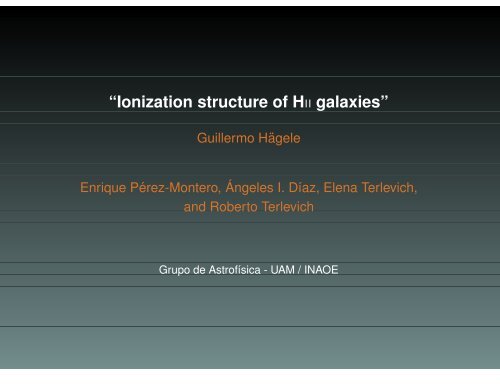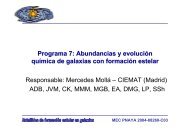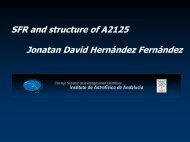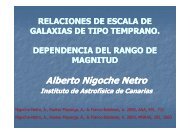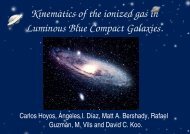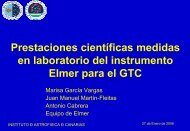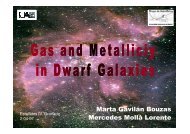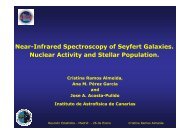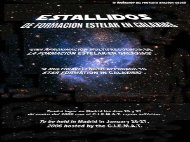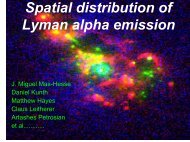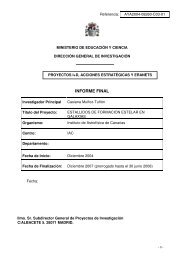“Ionization structure of HII galaxies”
âIonization structure of HII galaxiesâ
âIonization structure of HII galaxiesâ
You also want an ePaper? Increase the reach of your titles
YUMPU automatically turns print PDFs into web optimized ePapers that Google loves.
<strong>“Ionization</strong> <strong>structure</strong> <strong>of</strong> <strong>HII</strong> <strong>galaxies”</strong><br />
Guillermo Hägele<br />
Enrique Pérez-Montero, Ángeles I. Díaz, Elena Terlevich,<br />
and Roberto Terlevich<br />
Grupo de Astr<strong>of</strong>ísica - UAM / INAOE
Introduction:<br />
- <strong>HII</strong> galaxies are low mass irregular galaxies with, at least, a recent episode <strong>of</strong> violent<br />
star formation concentrated in a few parsecs close to their cores.
Introduction:<br />
- <strong>HII</strong> galaxies are low mass irregular galaxies with, at least, a recent episode <strong>of</strong> violent<br />
star formation concentrated in a few parsecs close to their cores.<br />
- The ionizing fluxes originated by these young massive stars dominate the light, the<br />
ionization degree and temperature <strong>of</strong> their interstellar gas.
Introduction:<br />
- <strong>HII</strong> galaxies are low mass irregular galaxies with, at least, a recent episode <strong>of</strong> violent<br />
star formation concentrated in a few parsecs close to their cores.<br />
- The ionizing fluxes originated by these young massive stars dominate the light, the<br />
ionization degree and temperature <strong>of</strong> their interstellar gas.<br />
- Thus, these systems have an emission line spectrum very similar to those <strong>of</strong> the<br />
extragalactic giant <strong>HII</strong> regions.
Introduction:<br />
- <strong>HII</strong> galaxies are low mass irregular galaxies with, at least, a recent episode <strong>of</strong> violent<br />
star formation concentrated in a few parsecs close to their cores.<br />
- The ionizing fluxes originated by these young massive stars dominate the light, the<br />
ionization degree and temperature <strong>of</strong> their interstellar gas.<br />
- Thus, these systems have an emission line spectrum very similar to those <strong>of</strong> the<br />
extragalactic giant <strong>HII</strong> regions.<br />
- The physical properties <strong>of</strong> these objects are usually derived combining photoionization<br />
model results and observed emission line intensity ratios.
Introduction:<br />
- <strong>HII</strong> galaxies are low mass irregular galaxies with, at least, a recent episode <strong>of</strong> violent<br />
star formation concentrated in a few parsecs close to their cores.<br />
- The ionizing fluxes originated by these young massive stars dominate the light, the<br />
ionization degree and temperature <strong>of</strong> their interstellar gas.<br />
- Thus, these systems have an emission line spectrum very similar to those <strong>of</strong> the<br />
extragalactic giant <strong>HII</strong> regions.<br />
- The physical properties <strong>of</strong> these objects are usually derived combining photoionization<br />
model results and observed emission line intensity ratios.<br />
- However, there are several major unsolved problems that limit the confidence <strong>of</strong><br />
present results, among them:<br />
(1) the effect <strong>of</strong> temperature <strong>structure</strong> in multiple-zone models (Pérez-Montero & Díaz<br />
2003, PMD03)<br />
(2) the presence <strong>of</strong> temperature fluctuations across the nebula (Peimbert 1967, ...)<br />
(3) collisional and density effects on ion temperatures (Luridiana et al. 1999, PMD03)<br />
(4) the ionization <strong>structure</strong> not adequately reproduced by current models (PMD03)
Observations:<br />
- In order to be able to solve these problems they are needed good quality spectra, with<br />
good S/N and spectral range.
¢<br />
¡<br />
£<br />
£¤<br />
§ ¦<br />
¦ §<br />
© ¦<br />
¨§<br />
£<br />
¦<br />
¥<br />
¢<br />
Observations:<br />
- In order to be able to solve these problems they are needed good quality spectra, with<br />
good S/N and spectral range.<br />
- Our objects were selected from the whole SDSS DR2 spectral catalog using the INAOE<br />
Virtual Observatory superserver<br />
Selection criteria: emission line galaxies with EW(H<br />
50 Å, 1.2<br />
(H<br />
)<br />
7 Å,<br />
z<br />
0.2, F(H<br />
)<br />
4<br />
10<br />
erg cm<br />
s<br />
Å
¢<br />
¡<br />
£<br />
£¤<br />
¨§<br />
§<br />
¦ §<br />
© ¦<br />
£<br />
¦<br />
¦<br />
¥<br />
¢<br />
Observations:<br />
- In order to be able to solve these problems they are needed good quality spectra, with<br />
good S/N and spectral range.<br />
- Our objects were selected from the whole DR2 spectral catalog using the INAOE<br />
Virtual Observatory superserver<br />
Selection criteria: emission line galaxies with EW(H<br />
50 Å, 1.2<br />
(H<br />
)<br />
7 Å,<br />
z<br />
0.2, F(H<br />
)<br />
4<br />
10<br />
erg cm<br />
s<br />
Å<br />
- This preliminary list was processed using BPT (Baldwin, Phillips & Terlevich 1981)<br />
diagnostic diagrams in order to remove AGNs (Jesús López, MSc Thesis, INAOE, 2005).
£¤<br />
¢<br />
¡<br />
£<br />
¨§<br />
§<br />
¦ §<br />
© ¦<br />
£<br />
¦<br />
¦<br />
¥<br />
¢<br />
Observations:<br />
- In order to be able to solve these problems they are needed good quality spectra, with<br />
good S/N and spectral range.<br />
- Our objects were selected from the whole DR2 spectral catalog using the INAOE<br />
Virtual Observatory superserver<br />
Selection criteria: emission line galaxies with EW(H<br />
50 Å, 1.2<br />
(H<br />
)<br />
7 Å,<br />
z<br />
0.2, F(H<br />
)<br />
4<br />
10<br />
erg cm<br />
s<br />
Å<br />
- This preliminary list was processed using BPT (Baldwin, Phillips & Terlevich 1981)<br />
diagnostic diagrams in order to remove AGNs (Jesús López, MSc Thesis, INAOE, 2005).<br />
- Then, by an independent visual inspection <strong>of</strong> each object we have selected the final<br />
sample.
£¤<br />
¢<br />
¡<br />
£<br />
¨§<br />
§<br />
¦ §<br />
© ¦<br />
¥<br />
¢<br />
£<br />
¦<br />
¦<br />
Observations:<br />
- In order to be able to solve these problems they are needed good quality spectra, with<br />
good S/N and spectral range.<br />
- Our objects were selected from the whole DR2 spectral catalog using the INAOE<br />
Virtual Observatory superserver<br />
Selection criteria: emission line galaxies with EW(H<br />
50 Å, 1.2<br />
(H<br />
)<br />
7 Å,<br />
z<br />
0.2, F(H<br />
)<br />
4<br />
10<br />
erg cm<br />
s<br />
Å<br />
- This preliminary list was processed using BPT (Baldwin, Phillips & Terlevich 1981)<br />
diagnostic diagrams in order to remove AGNs (Jesús López, MSc Thesis, INAOE, 2005).<br />
- Then, by an independent visual inspection <strong>of</strong> each object we have selected the final<br />
sample.<br />
- The SDSS spectroscopic data have a resolution (R) <strong>of</strong> 1800-2100 covering a spectral<br />
range from 3800 to 9200 Å, with a single 3” diameter aperture.
£¤<br />
¢<br />
¡<br />
£<br />
¨§<br />
§<br />
¦ §<br />
© ¦<br />
¥<br />
¢<br />
£<br />
¦<br />
¦<br />
Observations:<br />
- In order to be able to solve these problems they are needed good quality spectra, with<br />
good S/N and spectral range.<br />
- Our objects were selected from the whole DR2 spectral catalog using the INAOE<br />
Virtual Observatory superserver<br />
Selection criteria: emission line galaxies with EW(H<br />
50 Å, 1.2<br />
(H<br />
)<br />
7 Å,<br />
z<br />
0.2, F(H<br />
)<br />
4<br />
10<br />
erg cm<br />
s<br />
Å<br />
- This preliminary list was processed using BPT (Baldwin, Phillips & Terlevich 1981)<br />
diagnostic diagrams in order to remove AGNs (Jesús López, MSc Thesis, INAOE, 2005).<br />
- Then, by an independent visual inspection <strong>of</strong> each object we have selected the final<br />
sample.<br />
- The SDSS spectroscopic data have a resolution (R) <strong>of</strong> 1800-2100 covering a spectral<br />
range from 3800 to 9200 Å, with a single 3” diameter aperture.<br />
- The data were reduced and flux-calibrated using automatic pipelines.
Observations: WHT<br />
- The intermediate resolution blue and far red longslit spectra were obtained<br />
simultaneously during an observing run <strong>of</strong> one night using the ISIS double beam<br />
spectrograph <strong>of</strong> the WHT.<br />
Spectral range Disp. FWHM Spatial res.<br />
blue 3200-5700 0.86Å 2.5Å 0.2”/px<br />
red 5500-10550 1.64Å 4.8Å 0.2”/px<br />
2.4e-15<br />
2.1e-15<br />
[OII] 3727<br />
Ηβ<br />
[OIII] 4959<br />
[OIII] 5007<br />
1.4e-15<br />
1.2e-15<br />
Ηα<br />
1.8e-15<br />
Flux (erg cm -2 s -1 Å -1 )<br />
1.5e-15<br />
1.2e-15<br />
9e-16<br />
6e-16<br />
3e-16<br />
[NeIII] 3868<br />
Ηδ<br />
Ηγ<br />
[OIII] 4363<br />
Flux (erg cm -2 s -1 Å -1 )<br />
1e-15<br />
8e-16<br />
6e-16<br />
4e-16<br />
2e-16<br />
HeI 5876<br />
[SIII] 6312<br />
[SII] 6717,6731<br />
[OII] 7319,7330<br />
[SIII] 9069<br />
[SIII] 9532<br />
3500 4000 4500 5000 5500<br />
Wavelength ( Å )<br />
6000 6500 7000 7500 8000 8500 9000 9500<br />
Wavelength ( Å )
Observations: WHT<br />
- The intermediate resolution blue and far red longslit spectra were obtained<br />
simultaneously during an observing run <strong>of</strong> one night using the ISIS double beam<br />
spectrograph <strong>of</strong> the WHT.<br />
- We have chosen the spectral range to measure simultaneously the Balmer<br />
discontinuity, and the nebular lines [OII] 3727 and [SIII] 9069, 9532. Moreover, we have<br />
measured other important lines such as [OIII] 4363, 4959, 5007, [SII] 4068, 6717, 6731,<br />
and [SIII] 6312.<br />
2.4e-15<br />
2.1e-15<br />
[OII] 3727<br />
Ηβ<br />
[OIII] 4959<br />
[OIII] 5007<br />
1.4e-15<br />
1.2e-15<br />
Ηα<br />
1.8e-15<br />
Flux (erg cm -2 s -1 Å -1 )<br />
1.5e-15<br />
1.2e-15<br />
9e-16<br />
6e-16<br />
3e-16<br />
[NeIII] 3868<br />
Ηδ<br />
Ηγ<br />
[OIII] 4363<br />
Flux (erg cm -2 s -1 Å -1 )<br />
1e-15<br />
8e-16<br />
6e-16<br />
4e-16<br />
2e-16<br />
HeI 5876<br />
[SIII] 6312<br />
[SII] 6717,6731<br />
[OII] 7319,7330<br />
[SIII] 9069<br />
[SIII] 9532<br />
3500 4000 4500 5000 5500<br />
Wavelength ( Å )<br />
6000 6500 7000 7500 8000 8500 9000 9500<br />
Wavelength ( Å )
Observations: WHT<br />
- The intermediate resolution blue and far red longslit spectra were obtained<br />
simultaneously during an observing run <strong>of</strong> one night using the ISIS double beam<br />
spectrograph <strong>of</strong> the WHT.<br />
- We have chosen the spectral range to measure simultaneously the Balmer<br />
discontinuity, and the nebular lines [OII] 3727 and [SIII] 9069, 9532. Moreover, we have<br />
measured other important lines such as [OIII] 4363, 4959, 5007, [SII] 4068, 6717, 6731,<br />
and [SIII] 6312.<br />
- All the WHT data were reduced using IRAF routines in the usual manner.
Measurements:<br />
- There are some differences between the measurements <strong>of</strong> the observed fluxes taken<br />
with both WHT and SDSS telescopes.
Measurements:<br />
- There are some differences between the measurements <strong>of</strong> the observed fluxes taken<br />
with both WHT and SDSS telescopes.<br />
- A possible explanation <strong>of</strong> these differences are the different apertures <strong>of</strong> the WHT and<br />
Sloan data, 0.5 and 3”, we are observing different zones <strong>of</strong> the galaxies.
Measurements:<br />
- There are some differences between the measurements <strong>of</strong> the observed fluxes taken<br />
with both WHT and SDSS telescopes.<br />
- A possible explanation <strong>of</strong> these differences are the different apertures <strong>of</strong> the WHT and<br />
Sloan data, 0.5 and 3”, we are observing different zones <strong>of</strong> the galaxies.<br />
- Then, the reddening constant, temperatures, densities and abundances derived using<br />
WHT and Sloan data may differ.
Physical conditions:<br />
- Electron temperatures and electron density have been computed from the emission line<br />
data using the five-level statistical equilibrium model in the task TEMDEN <strong>of</strong> IRAF<br />
(Pérez-Montero & Díaz 2003).
Physical conditions:<br />
- Electron temperatures and electron density have been computed from the emission line<br />
data using the five-level statistical equilibrium model in the task TEMDEN <strong>of</strong> IRAF<br />
(Pérez-Montero & Díaz 2003).<br />
- The emission-line ratios used to calculate each available temperature and density are<br />
Diagnostic<br />
n([SII])<br />
T([OIII])<br />
T([OII])<br />
T([SIII])<br />
T([SII])<br />
T([NII])<br />
Lines<br />
I(6717Å)/I(6731Å)<br />
(I(4959Å)+I(5007Å))/I(4363Å)<br />
I(3729Å)/(I(7319Å)+I(7330Å))<br />
(I(9069Å)+I(9532Å))/I(6312Å)<br />
(I(6717Å)+I(6731Å))/(I(4068Å)+I(4074Å))<br />
(I(6548Å)+I(6584Å))/I(5755Å)
Physical conditions:<br />
- Electron temperatures and electron density have been computed from the emission line<br />
data using the five-level statistical equilibrium model in the task TEMDEN <strong>of</strong> IRAF<br />
(Pérez-Montero & Díaz 2003).<br />
- The emission-line ratios used to calculate each available temperature and density are<br />
Diagnostic<br />
n([SII])<br />
T([OIII])<br />
T([OII])<br />
T([SIII])<br />
T([SII])<br />
T([NII])<br />
Lines<br />
I(6717Å)/I(6731Å)<br />
(I(4959Å)+I(5007Å))/I(4363Å)<br />
I(3729Å)/(I(7319Å)+I(7330Å))<br />
(I(9069Å)+I(9532Å))/I(6312Å)<br />
(I(6717Å)+I(6731Å))/(I(4068Å)+I(4074Å))<br />
(I(6548Å)+I(6584Å))/I(5755Å)<br />
- In one <strong>of</strong> the SDSS spectra (SDSS J003218.59+150014.2) it is not possible to<br />
calculate T([OII]).
¨<br />
<br />
<br />
¦<br />
Physical conditions:<br />
- When we can not measure the lines necessary to estimate a specific temperature we<br />
used relationships based on the grids <strong>of</strong> photoionization models.<br />
SDSS J003218.60+150014.2<br />
WHT<br />
SDSS<br />
n([SII]) 67: 56:<br />
T([OIII]) 1.29<br />
T([OII]) 1.47<br />
T([OII])<br />
1.35<br />
T([SIII]) 1.32<br />
T([SIII])<br />
1.27<br />
T([SII]) 0.91<br />
0.02 1.28<br />
0.05 —<br />
0.02 1.36<br />
0.07 —<br />
0.02 1.27<br />
0.04 0.92<br />
T([NII]) — —<br />
T([NII])<br />
densities in<br />
1.47<br />
0.05 1.36<br />
0.03<br />
0.02<br />
0.03<br />
0.06<br />
0.02<br />
and temperatures in 10<br />
K
¨<br />
<br />
<br />
¦<br />
Physical conditions:<br />
- When we can not measure the lines necessary to estimate a specific temperature we<br />
used relationships based on the grids <strong>of</strong> photoionization models.<br />
SDSS J162410.11-002202.5<br />
WHT<br />
SDSS<br />
n([SII]) 56: 66:<br />
T([OIII]) 1.24<br />
T([OII]) 1.54<br />
T([OII])<br />
1.33<br />
T([SIII]) 1.36<br />
T([SIII])<br />
1.23<br />
T([SII]) 1.12<br />
T([NII]) 1.42<br />
T([NII])<br />
densities in<br />
1.52<br />
0.01 1.16<br />
0.04 1.23<br />
0.01 1.25<br />
0.05 —<br />
0.01 1.14<br />
0.08 1.02<br />
0.08 —<br />
0.04 1.23<br />
0.01<br />
0.03<br />
0.01<br />
0.01<br />
0.09<br />
0.02<br />
and temperatures in 10<br />
K
Chemical abundances:<br />
- Ionic and total abundances <strong>of</strong> He, O, S, N, Ne, Ar and Fe are obtained using the<br />
stronger available emission lines detected in the studied spectra.
Chemical abundances:<br />
- Ionic and total abundances <strong>of</strong> He, O, S, N, Ne, Ar and Fe are obtained using the<br />
stronger available emission lines detected in the studied spectra.<br />
- Differences between the WHT and SDSS abundances are about 10 % in two cases,<br />
and they are in very good agreement, within the observational errors, in the other.
©<br />
Chemical abundances:<br />
- Ionic and total abundances <strong>of</strong> He, O, S, N, Ne, Ar and Fe are obtained using the<br />
stronger available emission lines detected in the studied spectra.<br />
- Differences between the WHT and SDSS abundances are about 10 % in two cases,<br />
and they are in very good agreement, within the observational errors, in the other.<br />
Relation between the S parameter and<br />
the total oxygen abundance in units <strong>of</strong><br />
12+log(O/H)<br />
Our three objects are in very good<br />
agreement with the empirical calibration<br />
(PMD05).
¡<br />
! <br />
<br />
<br />
<br />
<br />
<br />
¥<br />
<br />
¡<br />
<br />
<br />
<br />
'<br />
&©<br />
%¦<br />
#$<br />
"<br />
¥<br />
<br />
<br />
<br />
<br />
<br />
<br />
Balmer temperature: T(Bac)<br />
– To measure this value we have adjusted the continuum<br />
at both sides <strong>of</strong> the Balmer discontinuity.<br />
– We can only measure the B-jump in the WHT<br />
2.8e-16<br />
2.6e-16<br />
[OII] 3727<br />
H9<br />
[NeIII] 3868<br />
HeI + H8<br />
[NeIII] + H7<br />
spectra due to the SDSS spectral range is not ap-<br />
2.4e-16<br />
H10<br />
propriate.<br />
Flux (erg cm -2 s -1 Å -1 )<br />
2.2e-16<br />
2e-16<br />
1.8e-16<br />
1.6e-16<br />
H17<br />
H16 + HeI<br />
H15<br />
H13<br />
H12<br />
H11<br />
HeI 3820<br />
1.4e-16<br />
BJ<br />
1.2e-16<br />
(Liu et al. 2001)<br />
1e-16<br />
3500 3600 3700 3800 3900 4000<br />
Wavelength ( Å )<br />
T([OIII]) = 1.25<br />
0.02; 1.29<br />
0.02; 1.24<br />
0.01<br />
T(Bac) = 1.23<br />
0.27; 0.96<br />
0.16; 1.24<br />
0.27
¡<br />
¥<br />
<br />
¡<br />
<br />
<br />
<br />
'<br />
¥<br />
<br />
<br />
<br />
<br />
<br />
<br />
<br />
-,<br />
. <br />
<br />
¡+<br />
<br />
0<br />
¡<br />
<br />
0<br />
[OII] 3727<br />
H9<br />
[NeIII] 3868<br />
HeI + H8<br />
[NeIII] + H7<br />
H10<br />
H17<br />
H16 + HeI<br />
H15<br />
H13<br />
H12<br />
H11<br />
HeI 3820<br />
Balmer temperature: T(Bac)<br />
2.8e-16<br />
– To measure this value we have adjusted the continuum<br />
at both sides <strong>of</strong> the Balmer discontinuity.<br />
2.6e-16<br />
– We can only measure the B-jump in the WHT<br />
2.4e-16<br />
2.2e-16<br />
spectra due to the SDSS spectral range is not appropriate.<br />
BJ<br />
2e-16<br />
3500 3600 3700 3800 3900 4000<br />
Wavelength ( Å )<br />
1.8e-16<br />
Flux (erg cm -2 s -1 Å -1 )<br />
! <br />
<br />
<br />
<br />
<br />
<br />
1.6e-16<br />
1.4e-16<br />
&© <br />
%¦<br />
1.2e-16<br />
#$<br />
"<br />
1e-16<br />
(Liu et al. 2001)<br />
0.01<br />
0.02; 1.24<br />
0.02; 1.29<br />
T([OIII]) = 1.25<br />
0.27<br />
0.16; 1.24<br />
0.27; 0.96<br />
T(Bac) = 1.23<br />
– Assuming a one-ionization scheme:<br />
© 3<br />
%21 <br />
/,<br />
" <br />
<br />
)***<br />
(<br />
<br />
51<br />
©6<br />
/, 4
¡<br />
! <br />
<br />
<br />
<br />
<br />
<br />
¥<br />
<br />
¡<br />
<br />
<br />
<br />
'<br />
&©<br />
%¦<br />
#$<br />
"<br />
¥<br />
<br />
<br />
<br />
<br />
<br />
<br />
,<br />
©<br />
<br />
<br />
<br />
<br />
© 3<br />
%21 <br />
<br />
<br />
"<br />
<br />
. <br />
-,<br />
<br />
¡+<br />
)***<br />
(<br />
<br />
,<br />
0<br />
/,<br />
:,<br />
§ ,, ,7 ¦ ,87<br />
¨9 ,,87<br />
©<br />
<br />
9,, ,7 ¦<br />
<br />
51<br />
©6<br />
/, 4<br />
<br />
¡<br />
<br />
0<br />
Balmer temperature: T(Bac)<br />
– To measure this value we have adjusted the continuum<br />
at both sides <strong>of</strong> the Balmer discontinuity.<br />
– We can only measure the B-jump in the WHT<br />
2.8e-16<br />
2.6e-16<br />
[OII] 3727<br />
H9<br />
[NeIII] 3868<br />
HeI + H8<br />
[NeIII] + H7<br />
spectra due to the SDSS spectral range is not ap-<br />
2.4e-16<br />
H10<br />
propriate.<br />
Flux (erg cm -2 s -1 Å -1 )<br />
2.2e-16<br />
2e-16<br />
1.8e-16<br />
1.6e-16<br />
H17<br />
H16 + HeI<br />
H15<br />
H13<br />
H12<br />
H11<br />
HeI 3820<br />
1.4e-16<br />
BJ<br />
1.2e-16<br />
(Liu et al. 2001)<br />
1e-16<br />
3500 3600 3700 3800 3900 4000<br />
Wavelength ( Å )<br />
T([OIII]) = 1.25<br />
0.02; 1.29<br />
0.02; 1.24<br />
0.01<br />
T(Bac) = 1.23<br />
0.27; 0.96<br />
0.16; 1.24<br />
0.27<br />
– Assuming a one-ionization scheme:<br />
Then, the average temperature, T<br />
, and the root<br />
mean square temperature fluctuation, t<br />
, are<br />
T<br />
= 1.24<br />
0.37; 1.08<br />
0.24; 1.24<br />
0.31<br />
t<br />
= 0.005<br />
; 0.069<br />
0.029; 0.001
Recalculated chemical abundances:<br />
- We have recalculated the ionic and total abundances taking into account the<br />
temperature fluctuations (see work by Peimbert et al. ), helped by Jorge García-Rojas<br />
and César Esteban, only for the WHT spectra.
©<br />
Recalculated chemical abundances:<br />
- We have recalculated the ionic and total abundances taking into account the<br />
temperature fluctuations (see work by Peimbert et al. ), helped by Jorge García-Rojas<br />
and César Esteban, only for the WHT spectra.<br />
- There are significant differences only in the case that t<br />
0.15 and 0.25 dex.<br />
=0.069, and they are between
Preliminary conclusions:<br />
- The spectral range <strong>of</strong> SDSS can not be extended with new observations since it is very<br />
difficult to observe the same region <strong>of</strong> the galaxies, and the derived physical properties<br />
may vary.
Preliminary conclusions:<br />
- The spectral range <strong>of</strong> SDSS can not be extended with new observations since it is very<br />
difficult to observe the same region <strong>of</strong> the galaxies, and the derived physical properties<br />
may vary.<br />
- In some cases the temperature fluctuations could be no negligible, but we need more<br />
and better observations to confirm it.
Preliminary conclusions:<br />
- The spectral range <strong>of</strong> SDSS can not be extended with new observations since it is very<br />
difficult to observe the same region <strong>of</strong> the galaxies, and the derived physical properties<br />
may vary.<br />
- In some cases the temperature fluctuations could be no negligible, but we need more<br />
and better observations to confirm it.<br />
- We can estimate the temperature fluctuations and the Balmer temperature since our<br />
observations have a broad spectral range.
Preliminary conclusions:<br />
- The spectral range <strong>of</strong> SDSS can not be extended with new observations since it is very<br />
difficult to observe the same region <strong>of</strong> the galaxies, and the derived physical properties<br />
may vary.<br />
- In some cases the temperature fluctuations could be no negligible, but we need more<br />
and better observations to confirm it.<br />
- We can estimate the temperature fluctuations and the Balmer temperature since our<br />
observations have a broad spectral range.<br />
- We need better quality observations to measure the Paschen discontinuity, and, if it is<br />
possible, recombination lines, e. g. Carbon, Oxygen or Neon lines.
Preliminary conclusions:<br />
- The spectral range <strong>of</strong> SDSS can not be extended with new observations since it is very<br />
difficult to observe the same region <strong>of</strong> the galaxies, and the derived physical properties<br />
may vary.<br />
- In some cases the temperature fluctuations could be no negligible, but we need more<br />
and better observations to confirm it.<br />
- We can estimate the temperature fluctuations and the Balmer temperature since our<br />
observations have a broad spectral range.<br />
- We need better quality observations to measure the Paschen discontinuity, and, if it is<br />
possible, recombination lines, e. g. Carbon, Oxygen or Neon lines.<br />
That’s all, folks!
Measurements:<br />
– For Balmer and Paschen lines a conspicuous<br />
underlying stellar population is easily<br />
appreciable by the presence <strong>of</strong> absorption<br />
features that depress the emission lines.<br />
– We have defined a pseudo-continuum to<br />
measure these line fluxes.<br />
– The absorbed fractions <strong>of</strong> the fluxes are<br />
not the same for all lines, nore the proportions<br />
between the absorbed fractions and<br />
the emissions are the same.<br />
Flux (erg cm -2 s -1 Å -1 )<br />
3.5e-16<br />
3e-16<br />
2.5e-16<br />
2e-16<br />
1.5e-16<br />
[OII] 3727<br />
H13<br />
H12<br />
H11<br />
H10<br />
HeI 3820<br />
H9<br />
[NeIII] 3868<br />
HeI + H8<br />
3800 3900 4000 4100<br />
Wavelength ( Å )<br />
[NeIII] + H7<br />
[NII] + HeI<br />
[SII] 4068<br />
Ηδ
Measurements:<br />
– For Balmer and Paschen lines a conspicuous<br />
underlying stellar population is easily<br />
appreciable by the presence <strong>of</strong> absorption<br />
features that depress the emission lines.<br />
– We have defined a pseudo-continuum to<br />
measure these line fluxes.<br />
– The absorbed fractions <strong>of</strong> the fluxes are<br />
not the same for all lines, nore the propor-<br />
Flux (erg cm -2 s -1 Å -1 )<br />
3.5e-16<br />
3e-16<br />
2.5e-16<br />
2e-16<br />
1.5e-16<br />
[OII] 3727<br />
H13<br />
H12<br />
H11<br />
H10<br />
HeI 3820<br />
H9<br />
[NeIII] 3868<br />
HeI + H8<br />
[NeIII] + H7<br />
[NII] + HeI<br />
[SII] 4068<br />
Ηδ<br />
tions between the absorbed fractions and<br />
the emissions are the same.<br />
3800 3900 4000 4100<br />
Wavelength ( Å )<br />
- The fractional errors introduced by this effect on the four strongest Balmer emission<br />
lines are much lower than that on the other Balmer lines or the Paschen ones.
;<br />
><br />
=<br />
<<br />
Measurements:<br />
– For Balmer and Paschen lines a conspicuous<br />
underlying stellar population is easily<br />
appreciable by the presence <strong>of</strong> absorption<br />
features that depress the emission lines.<br />
– We have defined a pseudo-continuum to<br />
measure these line fluxes.<br />
– The absorbed fractions <strong>of</strong> the fluxes are<br />
not the same for all lines, nore the propor-<br />
Flux (erg cm -2 s -1 Å -1 )<br />
3.5e-16<br />
3e-16<br />
2.5e-16<br />
2e-16<br />
1.5e-16<br />
[OII] 3727<br />
H13<br />
H12<br />
H11<br />
H10<br />
HeI 3820<br />
H9<br />
[NeIII] 3868<br />
HeI + H8<br />
[NeIII] + H7<br />
[NII] + HeI<br />
[SII] 4068<br />
Ηδ<br />
tions between the absorbed fractions and<br />
the emissions are the same.<br />
3800 3900 4000 4100<br />
Wavelength ( Å )<br />
- The fractional errors introduced by this effect on the four strongest Balmer emission<br />
lines are much lower than that on the other Balmer lines or the Paschen ones.<br />
- Then,<br />
(H<br />
) have been calculated using only the four strongest Balmer emission lines<br />
(H<br />
, H<br />
, H<br />
and H<br />
).


